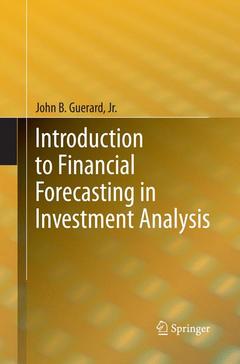Description
Introduction to Financial Forecasting in Investment Analysis, 2013
Author: Guerard, Jr. John B.
Language: English
Subjects for Introduction to Financial Forecasting in Investment Analysis:
Approximative price 105.49 €
In Print (Delivery period: 15 days).
Add to cartPublication date: 06-2015
Support: Print on demand
Approximative price 105.49 €
In Print (Delivery period: 15 days).
Add to cartPublication date: 01-2013
236 p. · 15.5x23.5 cm · Hardback
Description
/li>Contents
/li>Biography
/li>Comment
/li>
Forecasting?the art and science of predicting future outcomes?has become a crucial skill in business and economic analysis. This volume introduces the reader to the tools, methods, and techniques of forecasting, specifically as they apply to financial and investing decisions. With an emphasis on "earnings per share" (eps), the author presents a data-oriented text on financial forecasting, understanding financial data, assessing firm financial strategies (such as share buybacks and R&D spending), creating efficient portfolios, and hedging stock portfolios with financial futures. The opening chapters explain how to understand economic fluctuations and how the stock market leads the general economic trend; introduce the concept of portfolio construction and how movements in the economy influence stock price movements; and introduce the reader to the forecasting process, including exponential smoothing and time series model estimations. Subsequent chapters examine the composite index of leading economic indicators (LEI); review financial statement analysis and mean-variance efficient portfolios; and assess the effectiveness of analysts? earnings forecasts. Using data from such firms as Intel, General Electric, and Hitachi, Guerard demonstrates how forecasting tools can be applied to understand the business cycle, evaluate market risk, and demonstrate the impact of global stock selection modeling and portfolio construction.
John B. Guerard, Jr., is Director of Quantitative Research at McKinley Capital Management, Inc., in Anchorage, Alaska, specializing in quantitative models for stock selection and portfolio construction. For twenty years, he has served as a financial analyst, consultant, and executive, in such organizations as Drexel Burnham Lambert, Inc., Daiwa Securities Trust Co., Vantage Global Advisors, and Bryn Mawr Capital Management, Inc. He has taught courses in finance and investment at Rutgers University, New York University, and Lehigh University, among others, and has published in such journals as International Journal of Forecasting, Research in Finance, and Management Science. He is author or co-author of Handbook of Financial Decision Making (Probus Publishing Company, 1989), Forecasting Sales (JAI Press, 1994), Corporate Financial Policy and R&D Management (Wiley, 2005), Quantitative Corporate Finance (Springer, 2007), and editor of The Handbook of Portfolio Construction (Springer, 2009).
Comprehensive and accessible coverage of forecasting tools, techniques, and methodologies—as they apply to financial and investment analysis
Makes extensive use of historical data to illustrate both long- and short-term trends
Concepts are illustrated through real-life examples of companies such as Intel, General Electric, and Hitachi
Includes supplementary material: sn.pub/extras




